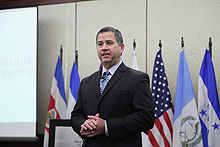 |
 Napolitano, Aguilar Address Central American Border Management Seminar
(03/05/2012) Last week Homeland Security Secretary Janet Napolitano and Acting CBP Commissioner Aguilar both addressed the Central America Border Management Seminar in Panama City, Panama as part of a week- long trip to Central America to solidify cooperative efforts with several countries in the region. Last week Homeland Security Secretary Janet Napolitano and Acting CBP Commissioner Aguilar both addressed the Central America Border Management Seminar in Panama City, Panama as part of a week- long trip to Central America to solidify cooperative efforts with several countries in the region.  |  | click for hi-res
 | | Acting Customs and Border Protection Commissioner David Aguilar speaks at the Central American Border Management Seminar. |
|
|  |  |
In her remarks on February 29, The Secretary indicated that the “region collectively faces criminal threats that are global in scope and origin and increasingly borderless.” Efforts to combat these threats must follow suit, and to be successful, must include enhanced communication and exchange of information. Napolitano mentioned some of the programs in which the region is participating such as the State Department-sponsored Central America Regional Security Initiative, known as CARSI, and the Advanced Passenger Information System (APIS) that provides information on travelers in advance of their boarding en route to the region.On Thursday, March 1, Acting Customs and Border Protection Commissioner David Aguilar pointed out that this was the first time that there had been a gathering like this. He stressed that the way that we look at our security responsibilities has changed since 9/11. Before the terrorist attacks, nations looked at their borders as a demarcation line at which we inspected, interviewed, and examined persons and cargo entering the country. Today, nations must take a different view. Boundaries are still important, but the focus must be on the entire flow of people and cargo. Gathering and sharing as much information as possible at the point of departure, during transit and at any intermediate stops until arrival is critical. The focus must be on the entire departure-to-arrival chain.  |  | click for hi-res
 | | Department of Homeland Security Secretary Janet Napolitano addresses participants attending the Central American Border Management Seminar. |
|
|  |  |
Over the course of the three- day conference, presenters from the Department of Homeland Security, Drug Enforcement Administration, CBP, other US government agencies, and Central American governments provided overviews on their roles in managing border security for representatives from Central American customs, immigration, and police agencies. In addition, participants had opportunities to participate in group discussions based on topics discussed in the seminar, including container security, integrated border management, and APIS. Later, each country‘s representatives met to discuss how the conference presentations related to their border security efforts. The recurring theme of the conference was the three things that can enhance border security: information sharing, interagency cooperation, and cross-border coordination. Cooperation, internally within each countries components with roles in border security, as well as inter- region between all countries in Central America and the U.S. The last component is coordination. All components in the entire border security process should work as an integrated system, eliminating inefficiencies and emphasizing that information is the critical component of the system.A common theme among the week’s presentations was that crime has no nationality and knows no boundary and hence the efforts to combat it must be regional. Several speakers reiterated the notion that no one program, initiative, agency or country can combat the criminal threat. The key to successfully combatting transnational crime at the borders is to engage in information exchange and cooperative efforts. |
 |
|  |  |
 |